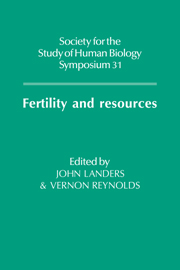Book contents
- Frontmatter
- Contents
- List of contributors
- 1 Introduction
- 2 Environmental and social determinants of fecundity in primates
- 3 Biological aspects of fertility among Third World populations
- 4 A preliminary report on fertility and socio-economic changes in two Papua New Guinea communities
- 5 The cultural context of fertility transition in immigrant Mennonites
- 6 Inter-relationships between consanguinity, religion and fertility in Karnataka, South India
- 7 Resources and the fertility transition in the countryside of England and Wales
- 8 Fertility decline and birth spacing among London Quakers
- 9 Population growth, innovation and resource exploitation
- 10 Fertility decline in developing countries: the roles of economic modernization, culture and Government interventions
- 11 Understanding recent fertility trends in the Third World
- 12 Monogamy, landed property and demographic regimes in pre-industrial Europe: regional contrasts and temporal stabilities
- Index
3 - Biological aspects of fertility among Third World populations
Published online by Cambridge University Press: 13 March 2010
- Frontmatter
- Contents
- List of contributors
- 1 Introduction
- 2 Environmental and social determinants of fecundity in primates
- 3 Biological aspects of fertility among Third World populations
- 4 A preliminary report on fertility and socio-economic changes in two Papua New Guinea communities
- 5 The cultural context of fertility transition in immigrant Mennonites
- 6 Inter-relationships between consanguinity, religion and fertility in Karnataka, South India
- 7 Resources and the fertility transition in the countryside of England and Wales
- 8 Fertility decline and birth spacing among London Quakers
- 9 Population growth, innovation and resource exploitation
- 10 Fertility decline in developing countries: the roles of economic modernization, culture and Government interventions
- 11 Understanding recent fertility trends in the Third World
- 12 Monogamy, landed property and demographic regimes in pre-industrial Europe: regional contrasts and temporal stabilities
- Index
Summary
Introduction
The absence of mechanization and transport facilities in the Third World requires subsistence farmers, horticulturalists and hunter-gatherers to sustain moderate to high energy expenditure (Lawrence et al, 1985; Bleiberg et al, 1980; Bentley, 1985). Their diet is mainly derived from noncultivated or home-grown food. Marked seasonal food shortage and chronic malnutrition are common occurrences (Bahuchet, 1988; Pagezy, 1984; Swinton, 1988; Bailey & Peacock, 1988; Hill et aL, 1984), and a varying form of adaptation might be needed to achieve a ‘long-term energy equilibrium’ (Ferro-Luzzi, 1988).
This is particularly relevant to rural areas where the phenomena concerning fertility are more acute than those observed in urban areas in the same countries. Recent immigrants to large urban areas have generally changed their diet to a more diversified one. At the same time women seem to reduce their physical workload, as many of them work as maids or sell home-baked food in the market, which is a quite different pattern of energy expenditure from that of the daily activity of women living in the bush. Another difference between urban and rural areas is the more widespread use of modern contraceptives in towns, including sterilization for men, or the use of long-duration contraceptives for women, such as six monthly injections of Depo-Provera.
In Third World populations, breastfeeding traditionally continues for long periods of time, and this is accompanied by a long duration of postpartum amenorrhoea with long birth intervals. Health care facilities are limited and the child mortality rate up to the age of five years is generally high.
- Type
- Chapter
- Information
- Fertility and Resources , pp. 18 - 34Publisher: Cambridge University PressPrint publication year: 1990
- 11
- Cited by



